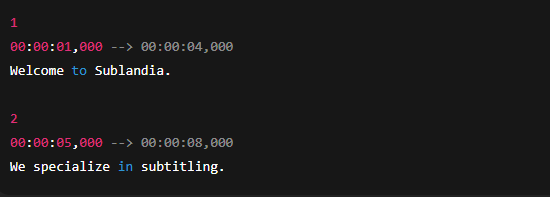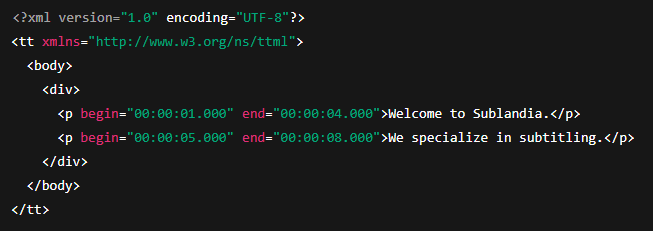 Understanding Subtitle File Formats: A Guide for Streaming Platforms, TV, and Film Production
Understanding Subtitle File Formats: A Guide for Streaming Platforms, TV, and Film Production
In the world of professional subtitling, choosing the right subtitle file format is crucial.
Whether you're producing content for a global streaming platform, a regional TV broadcaster, or cinematic release, the file type you deliver can directly impact timing, formatting, and compatibility.
Below is an overview of the most commonly used subtitle file formats, their differences, and where they best apply.
 SRT (SubRip Subtitle)
SRT (SubRip Subtitle)
Use Case: Universal / Streaming platforms / YouTube / Archiving
Pros:
 Widely supported (Netflix, Amazon Prime, YouTube)
Widely supported (Netflix, Amazon Prime, YouTube)
 Simple text-based format
Simple text-based format
 Lightweight and easy to edit
Lightweight and easy to edit
Cons:
 No support for rich formatting (font, color, style)
No support for rich formatting (font, color, style)
 No metadata or positioning control
No metadata or positioning control
Best For: Online streaming platforms and quick subtitle exchanges.
 STL (EBU Subtitles)
STL (EBU Subtitles)
Use Case: Broadcast television (Europe)
Pros:
 Standard format for European TV broadcasters (EBU)
Standard format for European TV broadcasters (EBU)
 Includes positioning, font style, in/out times
Includes positioning, font style, in/out times
Cons:
 Requires specialized software
Requires specialized software
 Less intuitive for non-professionals
Less intuitive for non-professionals
Best For: Traditional TV broadcasting, especially in Europe.
 PAC (Procap Subtitle File)
PAC (Procap Subtitle File)
Use Case: Professional broadcast / Cinema / Mastering
Pros:
 Supports precise timing and positioning
Supports precise timing and positioning
 Includes metadata, formatting, and language codes
Includes metadata, formatting, and language codes
 Used by professional subtitling houses
Used by professional subtitling houses
Cons:
 Requires proprietary software
Requires proprietary software
 Not compatible with open platforms like YouTube
Not compatible with open platforms like YouTube
Best For: High-end post-production, film distribution, and TV mastering.
 Other Formats
Other Formats
 TTML (Timed Text Markup Language) – Used by Netflix, XML-based with rich formatting.
TTML (Timed Text Markup Language) – Used by Netflix, XML-based with rich formatting.
 DFXP (Distribution Format Exchange Profile) – A subset of TTML, often used in streaming.
DFXP (Distribution Format Exchange Profile) – A subset of TTML, often used in streaming.
 VTT (WebVTT) – HTML5 compatible, used for web players.
VTT (WebVTT) – HTML5 compatible, used for web players.
 ASS/SSA (Advanced SubStation Alpha) – Supports rich formatting, ideal for anime/fansubs.
ASS/SSA (Advanced SubStation Alpha) – Supports rich formatting, ideal for anime/fansubs.
 Common Subtitle Formats by Platform:
Common Subtitle Formats by Platform:
 Universal Use: SRT
Universal Use: SRT
 Broadcast Standard (EU): STL
Broadcast Standard (EU): STL
 Professional Mastering: PAC
Professional Mastering: PAC
 Netflix: TTML / DFXP
Netflix: TTML / DFXP
 Amazon Prime: SRT / TTML
Amazon Prime: SRT / TTML
 YouTube: SRT / VTT
YouTube: SRT / VTT
FAQ – Common Questions about Subtitle Formats
1. What is the most universal format?
SRT is the most compatible and widely accepted due to its simplicity and flexibility.
2. Why does Netflix prefer TTML?
TTML supports rich styling and precise timing, important for high production quality.
3. When is STL used?
STL is the standard for TV broadcast, especially in Europe.
4. Which format is best for DVD and Blu-ray?
PAC is most commonly used in film post-production and physical releases.
5. How to choose the right format?
Always check the client or platform requirements. For most online platforms, SRT is a safe and practical choice.
 Final Thoughts
Final Thoughts
When deciding on a subtitle format, consider the final platform, required features (styling, positioning, metadata), and technical compatibility.
At Sublandia, we deliver subtitles in all major formats and tailor them for specific use cases—whether you're uploading to Netflix, preparing content for TV, or mastering a feature film.
 Need help choosing the right format or converting files?
Need help choosing the right format or converting files?
Contact Sublandia for expert subtitling solutions tailored to your distribution channel.
 Additional Info on Preparing Subtitle Files
Additional Info on Preparing Subtitle Files
and How to Create SRT / TTML Files
How to create an SRT file?
SRT (SubRip Subtitle File) is the simplest and most widely used subtitle format. It consists of numbered sections containing time codes and subtitle text.
Explanation:
 Each section starts with a sequence number.
Each section starts with a sequence number.
 Then come the time codes (start and end time) in hours:minutes:seconds,milliseconds format.
Then come the time codes (start and end time) in hours:minutes:seconds,milliseconds format.
 The subtitle text is below.
The subtitle text is below.
 There is a blank line between sections.
There is a blank line between sections.
Tools to create/edit SRT files:
 Subtitle Edit — free subtitle creation and editing tool.
Subtitle Edit — free subtitle creation and editing tool.
 Notepad or any plain text editor (if you know the structure).
Notepad or any plain text editor (if you know the structure).
Tips for high-quality SRT files:
 Use short, clear lines (max 2 lines per segment).
Use short, clear lines (max 2 lines per segment).
 Synchronize subtitles precisely with speech.
Synchronize subtitles precisely with speech.
 Avoid overlapping subtitles.
Avoid overlapping subtitles.
 Check spelling and style.
Check spelling and style.
How to create a TTML file?
TTML (Timed Text Markup Language) is an XML-based subtitle format that supports rich styling and precise display control.
Explanation:
 begin and end attributes set the display time.
begin and end attributes set the display time.
 Subtitle text is inside <p> tags.
Subtitle text is inside <p> tags.
 Styling (colors, fonts, positioning) can be added with extra attributes and styles.
Styling (colors, fonts, positioning) can be added with extra attributes and styles.
Tools to work with TTML:
 Subtitle Edit (can export TTML).
Subtitle Edit (can export TTML).
 EZTitles (professional software).
EZTitles (professional software).
 Professional production software.
Professional production software.
Advantages of TTML:
 Flexibility and device compatibility.
Flexibility and device compatibility.
 Standard for streaming services (Netflix, Amazon).
Standard for streaming services (Netflix, Amazon).
 Supports fonts, colors, positioning, and complex animations.
Supports fonts, colors, positioning, and complex animations.
 General tips for preparing subtitle files
General tips for preparing subtitle files
 Check source video:
Check source video:
Ensure accurate video timestamps.
 Synchronization:
Synchronization:
Subtitles must be tightly synced with speech or audio.
 Formatting:
Formatting:
Keep subtitles clear, concise, and compliant with target platform standards.
 File encoding:
File encoding:
Use UTF-8 encoding to support special characters (e.g., accented letters).
 Testing:
Testing:
Always test subtitles on the target platform/device before final delivery.

